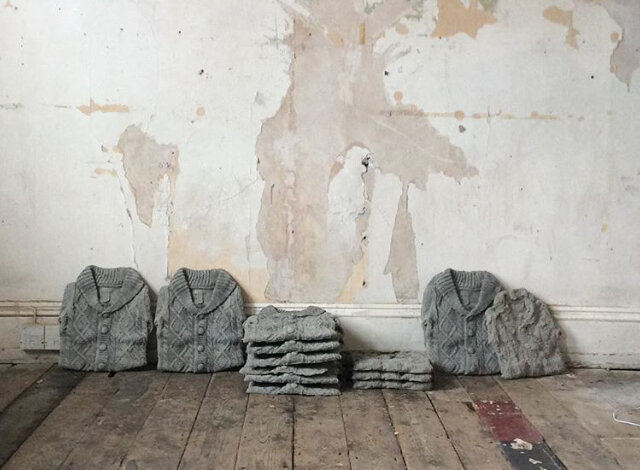Camilla Hanney

Visiting Camilla Hanney’s studio in what used to be a fitness center and is now repurposed by Goldsmiths for its MA Fine Art students, is entering a world of stories. The techniques and materials Camilla works with seem almost too feminine and reminiscent of a past of female arts and crafts. The works currently in her studio are as fragile in materials as they are loaded with meaningful history. And that is exactly the point. Her works are alive with stories and ‘her’story.
Camilla’s works are inspired pieces about history which she successfully translates to contemporary situations. She works from what she knows and grounds her works in rigorous research on the subjects that she discusses.
Originally from Ireland, a lot of her works are inspired by the stories of women in Ireland, like the history of the Catholic church over women’s rights and bodies. For a group show at Safehouse in Deptford, a former home to women who fled abusive relationships and their children, Camilla worked on an installation acknowledging the space and its history and added her Irish heritage to it. Children’s Aran knit jumpers, poured in concrete lean against the wall like gravestones. This opens up its own narrative as well - there is a rich history connected to this kind of jumper, but I will let you research that in your own time. On the wall, a cross formed out of dozens of ornaments made from human hair, reminiscent of a Victorian past and tradition. All this, telling a story of the Irish mother and baby homes, which were still active until 1966 and which seemingly gave a home to women who got pregnant out of wedlock. But once the baby was born, it was separated from its mother and put up for adoption.
Camilla’s talent to know and feel the space surrounding her is also apparent in a work about the history of the Deptford Dockyard. Once the dockyard was turned into a cattle market, women were hired in the gutting sheds for their small fingers. How scandalous! A religious institution was set up to remove these women from their trade and train them in domestic skills so they could be relocated to work in houses. Why was it such a problem for women to work so closely with blood? An installation of felt, animal bones, casts of rats and mice, and a bloody wallpaper asks exactly this question without being intrusive. Alongside, two contemporary articles contradicting each other, printed on handkerchiefs and framed in a tambour. This element of interpretation is not uncommon to her work, telling the stories of many at once.
Lace, she tells me has many layers of meaning, it reveals and it conceals at the same time and has simultaneous associations with pureness and Christianity, and shocking nudity. During the Irish famine, I learn, the women of the suffering families would take up lace making as a trade and often become the main provider of the family through it.
Her oyster originates in the idea that the porcelain vagina replaces the pearl in the shell, as a play on the well-known metaphor. The pearl, a symbol of purity and innocence, is made out of “dirt and grime” and born through a “process of dirt and irritation”. This mirrors a maternal moment in which we ourselves are born in a messy process to become ourselves - precious. The successful moment of this work in particular is that it is not screaming scandal from afar, but it asks the viewer to come closer and inspect it before its form becomes apparent.
The current work in progress is again working in porcelain with a long and exhausting process of pouring porcelain into slip-cast molds made from clay figures. Those figures of female bodies without heads or arms or legs succumb to a scandalous anonymity that seems so freeing to the way they perform their bodies. Those objects translate the tension between beauty and impurity of the naked female body into objects. ‘Porcelain is much stronger and robust than we tend to think,’ Camilla says. Opening up the dialogue between the seemingly fragile female body and it’s hidden(?) strength. Working with a material such as porcelain has its surprises. Some of the figurines split right down the middle when they are in the oven. This element of surprise and curiosity can be found in a lot of her works. Too much pressure on a female body and it breaks!? Maybe, but Camilla’s artistic practice doesn’t allow for just assuming and taking a loss. Flipping the two broken body parts on their sides and what was a female body just seconds ago becomes the visualisation of the reproductive system.
Thank you, Camilla, for an amazing first She Performs studio visit and we advise you all to keep an eye on her! We are sure we will see more great and powerful work coming from her studio while she works towards her Grad show in June 2019.
Lynn visited Camilla’s studio in Deptford, London on the 18th November 2018.












